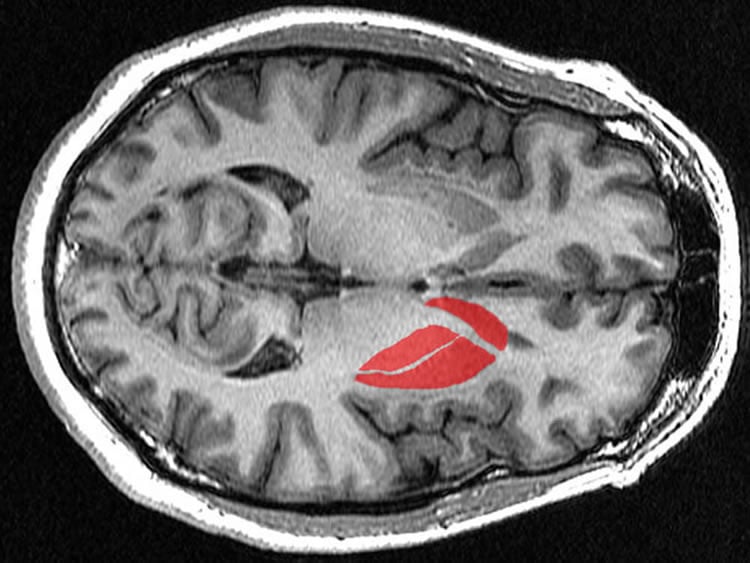Summary: Researchers identify a driving network for compulsivity in those with alcohol use disorders. The study reports heavy drinkers have more activity in the prefronal cortex, insular and striatum, areas of the brain critical for reward and decision making.
Source: Elsevier.
Heavy alcohol drinkers attempt to acquire alcohol despite the threat of a negative consequence more so than light drinkers, a study in Biological Psychiatry: Cognitive Neuroscience and Neuroimaging has found, and this behavior is associated with unique activation of brain circuitry in heavy drinkers.
The findings provide evidence for a “compulsivity circuit” that may drive alcohol-seeking behavior that is resistant to negative consequences, revealing potential targets for treatments to reduce compulsive alcohol use in heavy drinkers.
First author Erica Grodin, PhD, and colleagues designed a task to assess compulsive behavior of heavy and light drinkers. In contrast to habits–which drive behavior automatically even when it’s no longer rewarding–compulsive behavior continues despite negative consequences. In the task, participants could risk receiving a painful electric shock to earn points for alcohol or food.
Heavy drinkers tried to earn alcohol despite the risk for shock, whereas light drinkers tended to not take the risk. Both groups were willing to seek alcohol and food rewards when there was no threat of a shock.

“This study is important because it is the first study to investigate compulsive alcohol seeking in a heavy drinking population,” said Dr. Grodin, adding that previous studies have used animal models to try to understand this behavior.
Brain imaging conducted during the task revealed that heavy drinkers had more activity in brain regions associated with decision-making under conflict–the anterior insula and prefrontal cortex–and with habit and reward–the striatum. Imaging also revealed functional connections between two brain regions that were stronger in people with stronger compulsivity.
“This study highlights the complex rewiring that takes place in the heavy drinkers brain. Circuitry associated with conflict, risk and aversion become associated with those that process rewarding experiences, and this is associated with increased risky choice behavior when alcohol is a possible reward,” said Cameron Carter, MD, Editor of Biological Psychiatry: Cognitive Neuroscience and Neuroimaging.
The study was performed by researchers at the National Institute on Alcohol Abuse and Alcoholism, Bethesda, Maryland, Brown University, Providence, Rhode Island, and Linköping University, Sweden.
Source: Rhiannon Bugno – Elsevier
Publisher: Organized by NeuroscienceNews.com.
Image Source: NeuroscienceNews.com image is in the public domain.
Original Research: Abstract for “Neural Correlates of Compulsive Alcohol Seeking in Heavy Drinkers” by Erica N. Grodin Ph.D, Lauren Sussman B.S, Kelsey Sundby B.A, Grace M. Brennan B.S, Nancy Diazgranados M.D., M.S., Markus Heilig M.D., Ph.D., and Reza Momenan Ph.D. in Biological Psychiatry: Cognitive Neuroscience and Neuroimaging. Published July 9 2018.
doi:10.1016/j.bpsc.2018.06.009
[cbtabs][cbtab title=”MLA”]Elsevier”‘Compulsivity Circuit’ in Heavy Drinkers Identified.” NeuroscienceNews. NeuroscienceNews, 21 August 2018.
<https://neurosciencenews.com/alcoholism-compulsive-circuit-9720/>.[/cbtab][cbtab title=”APA”]Elsevier(2018, August 21). ‘Compulsivity Circuit’ in Heavy Drinkers Identified. NeuroscienceNews. Retrieved August 21, 2018 from https://neurosciencenews.com/alcoholism-compulsive-circuit-9720/[/cbtab][cbtab title=”Chicago”]Elsevier”‘Compulsivity Circuit’ in Heavy Drinkers Identified.” https://neurosciencenews.com/alcoholism-compulsive-circuit-9720/ (accessed August 21, 2018).[/cbtab][/cbtabs]
Abstract
Neural Correlates of Compulsive Alcohol Seeking in Heavy Drinkers
Background
Compulsive alcohol use, the tendency to continue alcohol seeking and taking despite negative consequences, is a hallmark of alcohol use disorder. Preclinical studies have suggested a role for the medial prefrontal cortex, anterior insula, and nucleus accumbens in compulsive alcohol seeking. It is presently unknown whether these findings translate to humans. We used a novel functional magnetic resonance imaging (fMRI) paradigm and tested the hypothesis that heavy drinkers would compulsively seek alcohol despite the risk of an aversive consequence, and that this behavior would be associated with the activity of fronto-striatal circuitry.
Methods
Non-treatment seeking heavy and light drinkers (n=21/group) completed an fMRI paradigm in which they could earn alcohol or food points at various threat levels (i.e., various probabilities of incurring an aversive consequence). Brain function was evaluated when individuals had the opportunity to earn reward points at the risk of an aversive consequence, an electric shock on the wrist.
Results
Compared with light drinkers, heavy drinkers attempted to earn more aversion-paired alcohol points. Fronto-striatal circuitry, including the medial prefrontal cortex, anterior insula, and striatum, was more active in this group when viewing threat-predictive alcohol cues. Heavy drinkers had increased connectivity between the anterior insula and the nucleus accumbens. Greater connectivity was associated with more attempts to earn aversion-paired alcohol points and self-reported compulsive alcohol use scores.
Conclusions
Higher activation of fronto-striatal circuitry in heavy drinkers may contribute to compulsive alcohol seeking. Treatments that disrupt this circuitry may result in a decrease in compulsive alcohol use.






